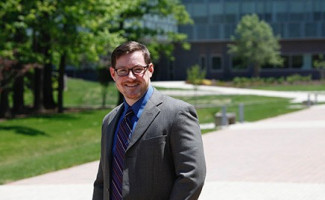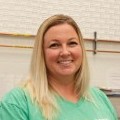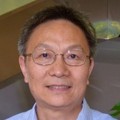The Physicist to Hollywood
Juggling Physics research and Hollywood consulting was bound to have its terrifying moments. James Maxwell, on-call physics advisor for the 2016 “Ghostbusters” film, was buried in research on high field polarization of Helium-3 when his cell phone rang. He stepped outside of a lab at Brookhaven National Laboratory to answer a call from Ghostbuster’s actress Melissa McCarthy. But “the call dropped!” Maxwell recalls, wide-eyed, as if reliving the shock and horror of a moment which later earned him a joking punch in the arm from McCarthy.
Luckily, the dropped call didn’t harm his rapport with Hollywood one bit. Maxwell, a post-doc at the Massachusetts Institute of Technology at the time, not only assisted directors and crew in creating the lab featured in the film, but he also trained the actors on how to interact with the lab equipment, advised on script dialog, marketing, props and even toys. He took this role very seriously and it landed him a place at the premier of the movie in Hollywood’s Chinese Theater and in the movie’s closing credits.
“It’s important to include physics in pop culture,” Maxwell said, scrolling through a file on his computer labeled “GB for Mom,” full of diagrams, abstracts and images of proton packs and lab sketches. “I got to inject real physics into this fun movie. I love the idea that people can look up these technical parts on Wikipedia and learn about real tools that real scientists use to study the universe.”
A Millennial in Science
A millennial physicist, born in 1982 in Poquoson, Virginia, who listened to The Rolling Stones while studying for his Ph.D. qualifying exams, Maxwell said he was mindful of this responsibility when advising Hollywood on physics.
Maxwell referenced another movie, “Interstellar,” where scientists must sacrifice 10 years of their lives simply to touch down on another planet. “It engages with the audience so deeply; the physics has real consequences,” he said. “There’s this vast emotional weight. They’re using physics to hit those emotional buttons.”
But in “Ghostbusters,” a movie he recalls seeing in its original version as a young child, physics is used differently. “These were cool scientists,” he said. “Ghostbusters use science as their super power: someone who has these tools can be a super-hero.”
From a High School Field Trip to Employment
Maxwell signed on as a “super-hero” staff scientist at Jefferson Lab in August of 2015, but he recalls visiting Jefferson Lab with an inspiring physics teacher when he was a high school student at New Horizon’s Governor’s School for Science & Technology. He said the Governor’s school was an early influence: “It was the first time I sat down and worked on physics and math and was able to use my mind creatively to understand things.”
He recalled being stumped by a difficult test question on electricity and magnetism. “Being able to figure it out was really empowering,” Maxwell said. “It was my first time feeling the synthesis happening in real time. To find that I could lead myself to a new connection and figure something out was really addicting.”
He decided to follow that feel-good feeling, which led him to the University of Virginia for the next 11 years, where he pursued his undergraduate and graduate degrees in Physics. At UVa, Maxwell played trumpet in the Virginia Pep Band, where he was a self-declared “hooligan” and lead joke writer (which caught the attention of his now wife, who played the trombone in the band).
“She didn’t like me during our first year at UVa,” Maxwell said, with a smile. “I’m a real nerd, but by the end of our fourth year, we had become best friends.”
His path lead him back to Newport News in 2008, when he worked on a JLab experiment for his PhD thesis. The experiment was called SANE, Spin Asymmetries on the Nucleon Experiment, and it gave Maxwell the opportunity to work for the first time with the Lab’s Polarized Target Group, planting a seed for his research interests that he would later turn into a full-time job.
“The Polarized Target Group was a bunch of cool dudes,” he said, “dudes that really knew how to make things work right in a crunch.”
His time working at JLab with the target group inspired him and pushed him to new levels as a scientist, leaving a lasting impact.
He followed his Ph.D. degree with a post-doc at the University of New Hampshire, where he again worked on JLab experiments, while his wife pursued master’s degrees at Boston University. After UNH, he went to MIT for three years as a post-doc. “It gave me a chance to be closer to my wife, and to keep working at a top notch laboratory for nuclear physics,” he said.
But when he heard about a position opening up at Jefferson Lab, he recalled his time there as a student and post-doc. He said it felt like a great chance to go home. “So we packed up and moved back here, because…” Maxwell spins in his chair and opens a video on his computer. “Ralph!”
Family Love: Overcoming Challenges by Sticking Together
Ralph is a bubbly 20-month-old toddler with blue eyes and blonde curls, named after his grandfather. The couple is expecting a second son in January 2018.
“You can’t quantify being a dad,” Maxwell said. “It just changes your orientation. Being a physicist is about pursuing knowledge and science and making America great in the way that was originally intended. It’s about furthering humanity. But having a kid is that, too.”
Maxwell learned early how to overcome challenges with family love. The son of a rheumatologist with his own medical practice and a mother who ran the practice, and as the older brother of a sibling with Cystic Fibrosis, he and his family faced challenges every day. “Your prognosis is rarely good when you have CF,” he said. “So, seeing my brother succeed been especially rewarding.”
Maxwell’s life now is a balance of family love, and exciting, challenging work. Inspired by Enrico Fermi, the Italian-American physicist who created the world’s first nuclear reactor, Maxwell is equally dedicated to furthering knowledge in physics and being a good dad.
After a full day of physics, bedtime with Ralph is one of his favorite times of each day. “Getting to sit with him and strum the ukulele with him,” he said. “He’s so cool.”
When asked how his Jefferson Lab work relates to his life’s mission, Maxwell doesn’t hesitate: “It’s about seeing the meaning in everything.”
What is a polarized target?
At Jefferson Lab, we scatter our electron beam from a target in each of the four experimental halls to probe the workings of nuclei and nucleons that make up that target. In polarized targets, we align the "spins" of the nuclei in the target material. Spin is a property of elementary particles like protons and electrons where they appear to be constantly rotating, giving off a tiny magnetic field. You can think of polarizing a material as like taking a bunch of spinning tops (these nuclei) and lining them up so they are all spinning in the same orientation. The more of the spins are aligned in the material, the more highly polarized it is.
What is being studied?
While solid polarized targets have been used in scattering experiments for decades, they remain a crucial tool for studying the make-up of matter. New experiments which look to explore new physics or improve previous measurements create new challenges for the targets that must be used. As we prepare for upcoming polarized target experiments in Halls B and C, the Target Group is working to build the next generation targets for Jefferson Lab's 12GeV era, hopefully giving more accurate polarization measurements, more efficient operation and higher polarization, all in the constraints that come with the new detector systems.
Why are polarized targets important?
Aligning the spins of the target material in a polarized target provides a crucial control to allow us to access different properties of the nucleon. Understanding how the spin of the quarks and gluons in the nucleus contribute to the workings of matter is a key goal of Jefferson Lab that often requires control over both the spin of the electron beam and the spin of the target.
How is this done?
To produce solid polarized targets, we first use a large, superconducting magnet, one that is stronger than most MRI magnets. This magnet will tend to align the spins in the material, like many small compasses lining up together. Next, we cool the sample to a very low temperature, only one degree above Absolute Zero, or -458 ºF. Under these conditions the polarization of the various subatomic particles varies greatly. For example, the electrons in the sample are almost completely polarized, while the protons and neutrons have very little polarization. So, we use a trick called Dynamic Nuclear Polarization to transfer some of the electron polarization to the nuclei. This involves a microwave beam tuned to a very precise frequency to cause some of the spins to reverse direction. Doing this we can produce over 90% polarization of protons in target materials like ammonia.
Where is this process done?
In Dynamic Nuclear Polarization, the target must be constantly held at a very high magnetic field, kept very cold, and under continuous microwave energy to hold the polarization of the nuclei at its highest values. This means we are working throughout the running of an experiment in the hall to keep the target polarized while the beam is scattered from it.
December 2017









































